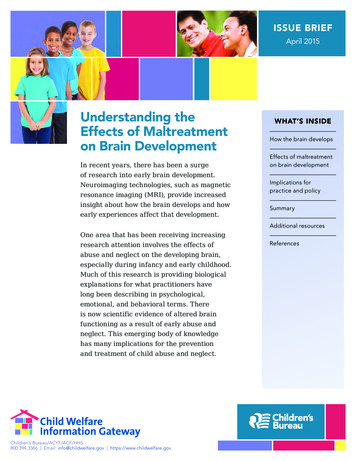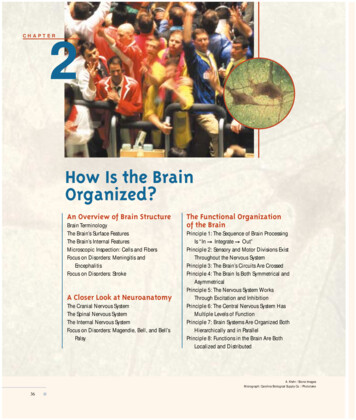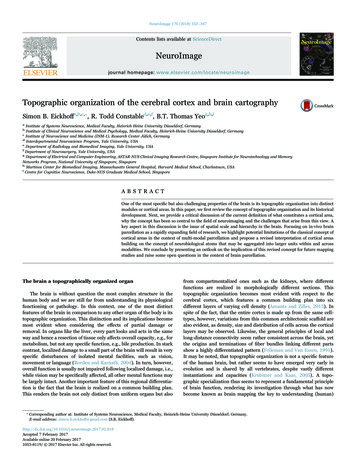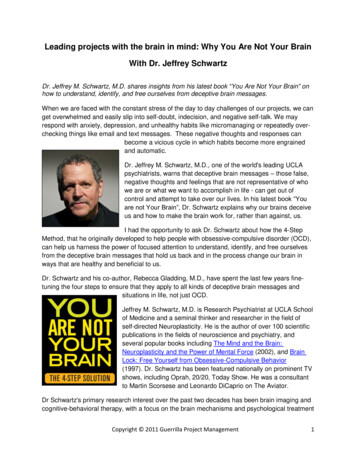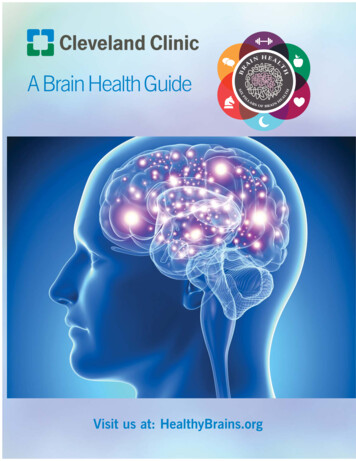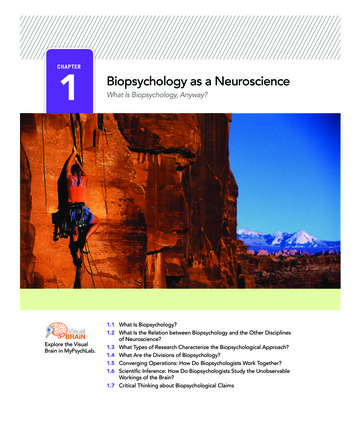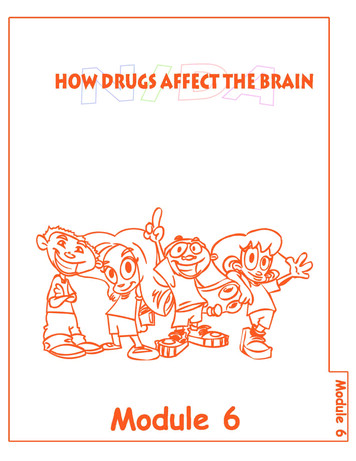
Transcription
Shifting into Brain 3.0 enables us to respond effectivelyStimulus(Stress)Brain 3.0ResponseStimulus(Stress)Brain 1.0/2.0ReactionFigure 1: This diagram illustrates how stressors normally bring us intoBrain 1.0 / 2.0, in which we react instinctively without being thoughtful.As we strengthen Brain 3.0, even when stressors occur, we are able to remaincentered.
8Brain 3.0How emotional states impact behaviorInitiate &CreateBrain 2.0Contribute &SupportParticipate/CompeteBrain 1.0Judge &CriticizeFight/WithdrawFigure 2: We can discern what emotional state people are in through theirbehavior.
180Calm ClarityHow emotional states impact interpersonal interactionsOther PartyBrain 3.0Brain 2.0Brain 1.0Brain 3.0Collaborationand creativityInspiration andsupportEmpathy andcompassionBrain 2.0Inspiration andsupportCompetition orcoalitionDomination orresentmentBrain 1.0Empathy andcompassionDomination orresentmentUnhealthyconflict oravoidanceYouFigure 3: Emotional states impact the way we interact with others and areoften contagious.
8Is your company bringing out the best in your people?What percent of time does your organization spendin Brain 1.0, Brain 2.0, and Brain 3.0?ToxicMyopicBrain 1.0InnovativeBrain 1.0Brain 1.0All companies impact and are impacted bythe brain activation of their employees.Figure 4: How much time an organization spends in Brain 1.0, Brain 2.0,and Brain 3.0 has an impact on its performance.
8How to strengthen the“emotional immune system”Calm Clarity’s Key MechanismsCalm Brain 1.0 andBrain 2.0 structuresthat trigger stressresponse andimpulsivenessExcercise and growBrain 3.0 structures forexecutive functioningand self-masteryElevate oxytocin(improves heart healthand lowers bloodpressure)Reduce cortisol andbuild resilience tostressful situationsVagus nerveImprove vagus nervefunction (contributesto relaxation, immunehealth, and formingsocial connections)Figure 7: These are the key mechanisms by which Calm Clarity techniques promotewell-being.Brain 1.0, Brain 2.0, and Brain 3.0 can be seen as embodied emotionalstates in that these three patterns of brain activation extend beyond the brain,* The “embodied brain” refers to the fact that the brain and body inextricably intertwine to generatethe experience of having a mind and thus also includes the nervous system, which connects the brainand body.
Idea, word,image,smell,soundFacialexpression& bodymovementsEmotionsand feelingsRelatedthoughtsand ideasMemoriesFigure 8: Associative Activation Cascade
I clench my hands; myarms and shoulders gettense; I have knots in mystomachIrritated and impatient,anxiousI think people who cutme off are jerks; I imagine worst- case scenariosabout being lateI switch lanes, honk alot, and run more yellowand red lights than usualI get mad at slowpedestrians, yell at otherdrivers, and don’t letcars pass in front of meWhat emotions do Ifeel?What thoughts andstories play out in mymind?How do I behavedifferently fromnormal?How do I treatpeople?Being stuck in rush- hour trafficTrigger example:Physical sensations:what happens inmy body?Triggers thatactivate Brain 1.0(my InnerGodzilla)Trigger 1Trigger 2Brain 1.0: S elf- PreservationTrigger 3Trigger 4
My mouth waters andstomach rumblesAnticipation and cravingI want to get mymoney’s worth andbinge on my favoritefoodsI eat two to three timesmore than normal, likethere is no tomorrowI compete to grab my fillof the best foods beforethey run outWhat emotions do Ifeel?What thoughts andstories play out inmy mind?How do I behavedifferently fromnormal?How do I treatpeople?An all- you- can- eatbuffetTrigger example:Physical sensations:what happens inmy body?Triggers thatactivate Brain 2.0(my Inner TeenWolf)Trigger 1Trigger 2Brain 2.0: Reward and AcquisitionTrigger 3Trigger 4
8Witnessing someonedo an act of kindnessMy heart feels warm andfuzzy, my chest opens,my eyes waterElevation, inspiration,admiration,connectednessI admire that person andwant to be more likehim or herI smile and don’t sweatthe small stuffI become nicer,friendlier, and warmer,even to strangersPhysical sensations:what happens inmy body?What emotions do Ifeel?What thoughts andstories play out in mymind?How do I behavedifferently fromnormal?How do I treatpeople?Trigger example:Triggers thatactivate Brain 3.0(my InnerSage)Trigger 1Trigger 2Brain 3.0: S elf- Mastery and W ell- BeingTrigger 3Trigger 4
Perception and learning Interpretation and internalization(Storytelling) Reinforcing experiences Hardwired beliefs, programs, and worldview 8Environment and social education and signalsMindset, personality, trajectory, and life scriptsFigure 9: How conditioning shapes our beliefs and mindset
Subtle &RefinedSOURCE (unmanifested)“TRUE SELF”Collective Consciousness (differentiated)Brain 3.0 Superconsciousness“Realm of incarnation”“Higher Self”“Collective Soup”“soul chakra”Brain 1.0 Brain 2.0Field of EntanglementDense &GrossGradations of Consciousness/Energy“Divine Transmissions”ALow Conductivity/High Resistance &High EntanglementBCSpiritual Conductivity &Energy TransmutationFigure 10: Bigger Picture Perspective on Brain 1.0, 2.0, and 3.0D “Samma Sati”Pure Conductivity/No Resistance &No Entanglement
To build further upon that metaphor, I explained that getting hijacked byBrain 3.0 enables us to effectively navigate lifeLeft Prefrontal CortexPositive Affect ‒See the upsidePursue growthopportunitiesOpen to connectionand building trustGasNegative Affect See the downside GOAPPROACHRight Prefrontal CortexAccurately diagnoseproblems and dangersTake precautionarymeasures and defendSTOPAVOIDBrakesFigure 5: The key structures of Brain 3.0, the left and right prefrontal cortices, have different functions in simulating the experience of affective states.
8Challenge: Brain 3.0 gets hijacked by Brain 1.0 & 2.0Left Prefrontal CortexPositive AffectBrain 1.0 drainsthe gas tankGas ‒XGOXSTOPRight Prefrontal CortexNegative AffectBrain 2.0 impairsthe brakesBrakesFigure 6: In Brain 1.0, activity in key areas of the left prefrontal cortex isreduced; in Brain 2.0, activity in key areas of the right prefrontal cortex isreduced.
8Appendix: Tools to ApplyThese Insights in Your LifeI would like to provide a few simple tools that can help you put the meditationsand exercises provided into practice in your daily life. These are:A. Reference Guide for the Calm Clarity Meditations and MindfulnessPracticesB. Template to Create a Practice Plan for Fostering Brain 3.0C. Template to Plan a Daily Routine to Activate Brain 3.0D. Recommended Reading ListA. R eference Guide for the Calm Clarity Meditationsand Mindfulness PracticesThe following table provides a summary of the underlying mechanisms andthe benefits of the practices in the Calm Clarity Mindful Leadership Program.1:07 PM9780143130970 CalmClarity TX.indd315 1/30/181:07 PM
316Appendix: Tools to Apply These Insights in Your LifePracticeMechanismsDeep BreathingStimulates the vagusPurpose and Benefits nerve(6‑3‑6‑3) sympathetic nervous system’sActivates theparasympathetic freeze- flight- fight cascade) nervous system (PNS)Compassion (Metta)Meditation Increases activity of left Strengthen emotional immuneprefrontal cortex (PFC)system and increase positiveStimulates the vagusemotions by “refilling the Brainincreases oxytocin Center and ground yourself inyour body through breathingnerve and PNS and Reduce stress (calm3.0 gas tank” Improve autopilot’s capacityPrimes compassion andfor compassion, empathy, andempathy neural circuitsconnectionInduces gamma Reduce brain fogsynchrony Steer mind wandering towardpositive thoughts and images(reduce rumination)Focused Exercises and Learn about your autopilotAttention andstrengthens neuralthrough self- observation andOpenpathways for focusedunpacking process of sensoryAwarenessattention andMeditationmetacognition perception Enhances sensory andconcentrate without gettinginteroceptiveawarenessIncrease ability to focus anddistracted Learn to stay grounded in thebody and in the presentmoment (reduce mindwandering) Develop equanimity andbeginner’s mind (let go ofpreconceptions)9780143130970 CalmClarity TX.indd316 1/30/181:07 PM
8Appendix: Tools to Apply These Insights in Your Life PracticeMechanismsMindful Exercises andBreathingstrengthens neuralMeditationpathways forPurpose and Benefits Develop space to detach fromthe m ind- track and get out ofinteroceptive Center and ground yourself inyour bodymetacognition andawareness317tunnel vision Become aware of yourShifts default modepreconditioning and neutrallynetwork (DMN) out ofwatch the associativerumination modeactivation of neural circuitswithout getting swept intoBrain 1.0 or Brain 2.0 Develop equanimity andbeginner’s mind (let go ofpreconceptions)Mindful Exercises andWalking (andstrengthens Brain 3.0bringingneural pathways formindfulnessfocused attention andto other dailyactivities) Develop presence by gettinggrounded in your body andtuning in to your senses Appreciate daily activities likemetacognitionwalking as opportunities toEnhancescenter and to learn moreproprioceptive andabout your autopilot and buildinteroceptivenew habitsawareness Get out of autopilot mode andtunnel vision and create spaceto widen your perspective andopen up to creative insights1:07 PM9780143130970 CalmClarity TX.indd317 1/30/181:07 PM
318Appendix: Tools to Apply These Insights in Your LifePracticeMechanismsMindful Eating Purpose and BenefitsEnhances sensory, Reduce mindless overeatinginteroceptive, and Develop presence by gettingproprioceptivegrounded in your body andawarenesstuning in to your senses in theActivates the vagusprocess of eating: the sight,nerve to tune in tosmell, texture, taste, andsignals from yourenteric nervous systemcrunch of foods Cultivate gratitude andand rev up the PNSappreciation for food and the rest- and- digestentire food supply chainfunctions Tap in to the body’s wisdom toguide what to eat and howmuch to eatB. T emplate to Create a Practice Plan for FosteringBrain 3.0This Practice Plan template is designed as a tool to help you integrate the CalmClarity practices and insights into your life. Your plan will be unique to yourneeds and interests. I suggest choosing three main goals to focus on at anygiven time. As you make progress toward these goals, you may want to choosenew goals. Alternatively, if you run into obstacles that prevent you from meeting these goals, you may want to revise the goal or plan to more effectivelyaccount for and address these obstacles. Therefore, I recommend that youmake a weekly or monthly appointment with yourself to review and updateyour Practice Plan. Please keep your plan in a convenient place where you canrefer to it regularly to review and/ or update it.9780143130970 CalmClarity TX.indd318 1/30/181:07 PM
8 Appendix: Tools to Apply These Insights in Your Life319My Practice Plan for Fostering Brain 3.0What I will applyPotential challengesPlan: When and HowC. Template to Plan a Daily Routine to ActivateBrain 3.0This Daily Routine template is designed as a tool to help you see how you canturn things that you already do into opportunities to activate Brain 3.0 neuralcircuits. Again, how you do s omething— whether you do it mindlessly or mindfully— can make a big difference. For instance, waking up can be a timeto set an intention for the day, a ride on the subway or bus can become anopportunity to practice compassion meditation, a walk to the water fountainor restroom can become a mindful walking exercise, and an afternoon coffee,tea, or snack break can be an opportunity to practice mindful eating. Ideally,your Daily Routine would be aligned with the three main goals in your Practice Plan.1:07 PM9780143130970 CalmClarity TX.indd319 1/30/181:07 PM
320Appendix: Tools to Apply These Insights in Your LifeMy Daily Routine to Activate Brain 3.0Waking UpEarly MorningBreakfastCommute to Work or SchoolMorningLunchAfternoonCommute HomeEveningDinnerNightGoing to Bed9780143130970 CalmClarity TX.indd320 1/30/181:07 PM
8Appendix: Tools to Apply These Insights in Your Life 321D. Recommended Reading ListTo learn more about neuroscience and neuroplasticity: Sharon Begley, Train Your Mind, Change Your Brain: How a New ScienceReveals Our Extraordinary Potential to Transform OurselvesRichard Davidson and Sharon Begley, The Emotional Life of Your Brain:How Its Unique Patterns Affect the Way You Think, Feel, and Live— andHow You Can Change ThemNorman Doidge, The Brain That Changes Itself: Stories of Personal Triumph from the Frontiers of Brain ScienceTo learn more about trauma: Bessel van der Kolk, The Body Keeps the Score: Brain, Mind, and Body inthe Healing of TraumaPeter A. Levine, In an Unspoken Voice: How the Body Releases Traumaand Restores GoodnessTo learn more about stress: Robert Sapolsky, Why Zebras Don’t Get Ulcers: The Acclaimed Guide toStress, Stress- R elated Diseases, and CopingKelly McGonigal, The Upside of Stress: Why Stress Is Good for You, andHow to Get Good at ItTo learn more about the autopilot and habits: Daniel Kahneman, Thinking, Fast and SlowDan Ariely, Predictably Irrational: The Hidden Forces That Shape Our DecisionsCharles Duhigg, The Power of Habit: Why We Do What We Do in Life andBusinessTo learn more about meditation: 1:07 PMA beginner’s guide to the Buddhist Vipassana meditation tradition:Bhante Henepola Gunaratana, Mindfulness in Plain English9780143130970 CalmClarity TX.indd321 1/30/181:07 PM
322 Appendix: Tools to Apply These Insights in Your LifeA secularized approach: Jon K abat- Zinn, Wherever You Go, There YouAre: Mindfulness Meditation in Everyday LifeA psychological and neurobiological perspective: Daniel Siegel, Mindsight: The New Science of Personal TransformationA humorous autobiographical account: Dan Harris, 10% Happier: HowI Tamed the Voice in My Head, Reduced Stress Without Losing My Edge,and Found S elf- Help That Actually W orks— A True StoryTo learn more about spiritual traditions:My personal preference is to read the original ancient texts to gain a moredirect understanding of the messages that the authors or spiritual founders ofthese traditions shared in their own words. Furthermore, I make it a point toread multiple translations so that I am not misled by the interpretation, biases,or agenda of any particular translator. I also find it helpful to look at translations from different eras to see how the interpretation of ancient words hasevolved over time. An online search will quickly bring up multiple versionsand commentaries on these texts that are freely available.The texts that I find very insightful to read and meditate on: The Bhagavad Gita The Yoga Sutras The Dhammapada The Mahasatipatthana Sutta (“The Great Discourse on the Establishingof Mindfulness”) The Bible (using the Interlinear Bible available at http:// biblehub.com) The Gnostic Gospels The Tao Te Ching (“Dao De Jing” in Pinyin) The Enchiridion and Discourses of Epictetus (The Golden Sayings of Epictetus is available free on Kindle)9780143130970 CalmClarity TX.indd322 1/30/181:07 PM
Is your company bringing out the best in your people? What percent of time does your organization spend in Brain 1.0, Brain 2.0, and Brain 3.0? All companies impact and are impacted by the brain activation of their employees. Brain 1.0 Brain 1.0 Brain 1.0. Toxic Myopic Innovative. Figure 4: How much time



